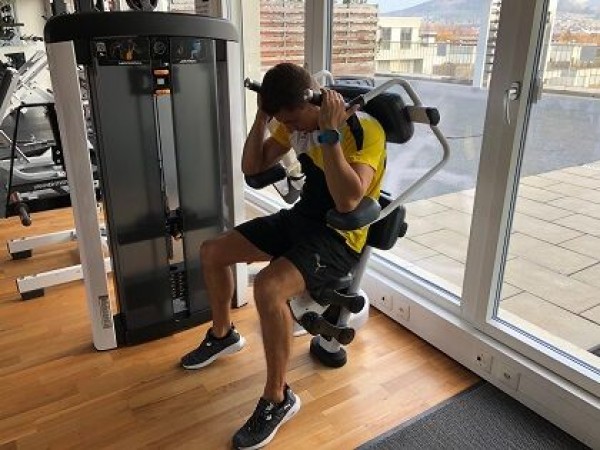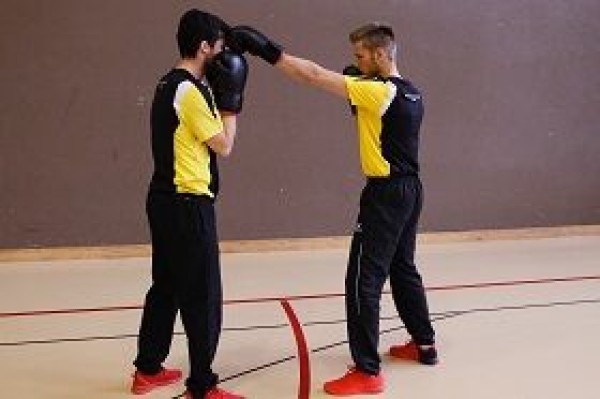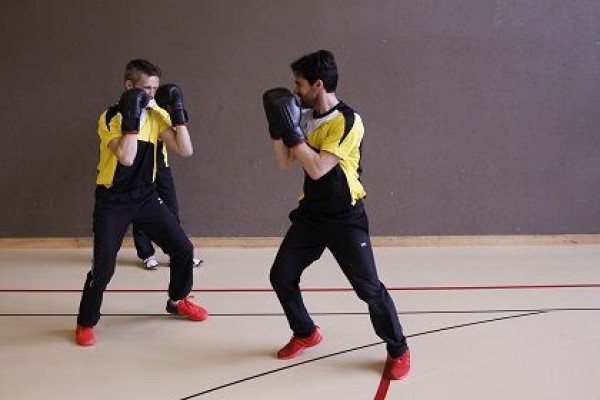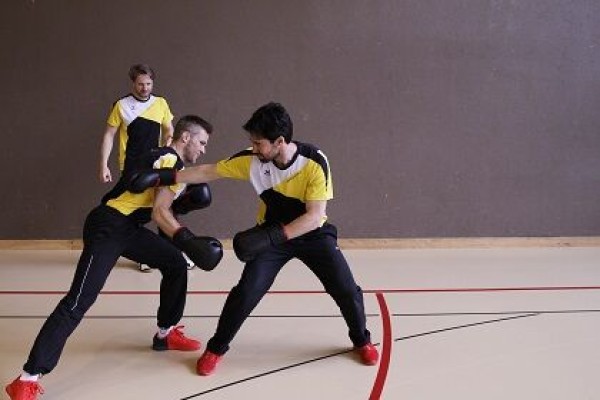Exercises (1723)
Lowering and raising the upper body while seated ► Abdominal crunch
Power
Individual work


Grab the handles behind your head and position your elbows on the cushions, tense your core muscles and pull your upper body down towards your legs, then raise your upper body back up to the starting position.
Starting position:
- Sitting with the upper body slightly overstretched
- Grasp the handles with your hands behind your head
- Rest your elbows on the cushion
Finishing position:
- Grip unchanged
- Bring your upper body closer to your legs
Attention:
Work from the core muscles, which means that you should not pull with your hands or push with your elbows.
Lowering and raising the upper body in the seat ► back extension / lower back
Power
Individual work


Place the shoulder blades on the cushion, push the upper body backwards from the forward-leaning position against the resistance while sitting, using the thigh and buttock muscles to support the lower back.
Starting position:
- Sitting with the upper body leaning forwards
- Straight back stretched out
Finishing position:
- Upright posture or upper body leaning backwards
- Position of the back unchanged
Lowering and raising the upper body while standing
Power
Individual work


Stand upright, shoulder-width apart with your feet in the loops. Hold the gymnastics pole with outstretched arms in an overhand grip slightly wider than hip-width in front of your body (back of hands pointing forwards), tilt your upper body forwards with a straight back and bend your knees slightly. Stretch your legs and straighten your upper body again to return to the starting position.
Attention:
The movement takes place in the hip joint, move the gymnastics bar close to your body, keep your back straight.
Lighten:
Choose less strong elastic bands; roll up the elastic bands less.
Harden:
Choose stronger elastic bands; roll up the elastic bands more.
Variation:
Hold the gymnastics bar on your shoulders behind your head (longer lever).
1 gymnastic bar with elasticated straps
Lowering and raising the upper body while standing
Power
Individual work


Stand with your feet shoulder-width apart and hold the gymnastics pole on your shoulders behind your head. Your feet are in the loops, your knees are slightly bent and your upper body is leaning forwards with a straight back. Bend your upper body and roll back up to the starting position.
Attention:
The pelvis remains stable and should not move, so try to straighten your upper body vertebra by vertebra.
Lighten:
Choose less strong elastic bands; roll up the elastic bands less.
Harden:
Choose stronger elastic bands; roll up the elastic bands more.
Variation:
Hold the gymnastics bar at knee height with outstretched arms instead of on your shoulders.
1 gymnastic bar with elasticated straps
Lowering and raising the upper body while standing
Power
Individual work


Stand upright, shoulder-width apart, hold a dumbbell/kettlebell in each hand in front of your body at hip height (backs of hands pointing forwards), tilt your upper body forwards with a straight back and move the weight towards your shins. Lower the weight as far as you can keep your back straight before raising your upper body back to the starting position.
Attention:
The movement takes place in the hip joint, move the weight close to the body, keep your back straight.
Lighten:
Less weight or no weight at all.
Harden:
More weight.
2 dumbbells/kettlebells
Lowering and raising the upper body while standing (left) ► windmill
Power
Individual work


Stand upright with the weight (dumbbell or kettlebell) with one arm (left) stretched out overhead (arm almost stretched out in an upright position), bend the leg (right - opposite side of the hand with the weight) and push the buttocks backwards without losing stability in the back, always looking towards the weight and finally lowering the upper body down/leaning forwards at an angle. The free arm (right) is brought crosswise to the shin of the extended leg (left). Then work the weight out of the torso in a controlled manner and push it back up to the upright starting position.
Starting position:
- Stand upright, shoulder-width apart
- Stabilise the weight with one arm overhead in a high position
- Tense the abdominal and gluteal muscles
- Look forwards
Finishing position:
- One leg extended, the other slightly bent (opposite side of the hand with the weight)
- Buttocks pushed backwards
- Upper body lowered/inclined forwards, free arm touches the shin crosswise
- Back remains straight
- Gaze directed towards the weight
Attention:
This exercise places high demands on mobility and stability, which is why it is only suitable for experienced exercisers.
1 dumbbell/kettlebell
Lowering and raising the upper body while standing (right) ► windmill
Power
Individual work

Stand upright with the weight (dumbbell or kettlebell) with one arm (right) stretched out overhead (arm almost stretched out in an upright position), bend the leg (left - opposite side of the hand with the weight) and push the buttocks backwards without losing stability in the back, always looking towards the weight and finally lowering the upper body down/leaning forwards at an angle. The free arm (left) is brought crosswise to the shin of the extended leg (right). Then work the weight out of the torso in a controlled manner and push it back up to the upright starting position.
Starting position:
- Stand upright, shoulder-width apart
- Stabilise the weight with one arm overhead in an upright position
- Tense the abdominal and gluteal muscles
- Look forward
Finishing position:
- One leg extended, the other slightly bent (opposite side of the hand with the weight)
- Buttocks pushed backwards
- Upper body lowered/inclined forwards, free arm touches the shin crosswise
- Back remains straight
- Gaze directed towards the weight
Attention:
This exercise places high demands on mobility and stability, which is why it is only suitable for experienced exercisers.
1 dumbbell/kettlebell
Lowering and raising the upper body while standing ► romanian deadlift
Power
Individual work


Start standing, bend your upper body so that the barrel of the rifle is pointing towards the ground and return to the starting position.
Lighten:
Bend/lower your upper body less.
1 assault rifle (neutralised)
Lowering and raising the upper body in prone position (hip and back extension) ► ghd hip and back extension
Power
Individual work
Place the thighs on the padding and fix the feet in the holder (feet pointing downwards). Make sure that the support pad is adjusted so that the hips are free and the legs are straight. The hips are extended, the exposed upper body is kept horizontal and the arms are held on the chest or crossed. From this position, lower the upper body, first lowering/tilting the chin towards the chest before starting to bend the spine in the neck. The upper back is then rolled up, followed by the lower back. Finally, the hips are flexed and the spine is briefly stretched. Once in the end position, the hips are stretched first in reverse order, while the spine is flexed. The hips remain stretched as the lower back and then the upper back are stretched. With a neutral spine and stretched hips, return to the starting position (upper body horizontal to the floor).
Caution:
Consciously curl or uncurl your back vertebra by vertebra.
Lighten:
-
Lighten:
Additional weight (on the chest)
1 glute-ham developer (GHD)
1 weight disc ►to make the exercise more difficult (additional weight)
Lowering and raising the upper body in prone position ► ghd back extension
Power
Individual work
Place your hips on the padding and fix your feet in the holder with your legs stretched out (feet pointing downwards). The hips are stretched, the exposed upper body is held horizontally with a neutral spine, the arms are held on the chest or crossed. From this position, lower the upper body, first lowering/tilting the chin towards the chest before starting to bend the spine in the neck. The upper back is then rolled up, followed by the lower back. Once in the final position, the back is rolled up again in reverse order to return to the starting position with a neutral spine (first stretch the lower back, then the upper back and finally the neck).
Attention:
Consciously roll your back in or up vertebra by vertebra.
Lighten:
-
Harden:
Additional weight (on the chest).
1 glute-ham developer (GHD)
1 weight disc ► to make the exercise more difficult (additional weight)
Lowering and raising the upper body in prone position ► ghd hip extension
Power
Individual work
Place the thighs on the padding and fix the feet in the holder (feet pointing downwards). Make sure that the support pad is adjusted so that the hips are free and the legs are straight. The hips are extended, the exposed upper body is kept horizontal and the arms are held on the chest or crossed. From this position, bend the hips as far as possible (while maintaining the lumbar curve). The return to the starting position is initiated by tensing the gluteal muscles and hamstrings. Finally, the upper body is raised again until the hips are fully extended (upper body horizontal to the floor).
Attention:
The position of the upper body remains unchanged (keep the torso tensed).
Lighten:
Lower the upper body less; support from a partner; place a raised object underneath the upper body to support yourself with your hands.
Harden:
Additional weight (on the chest); place hands with bent arms by the ears; arms held high (extension of the body).
1 glute-ham developer (GHD)
1 plyo box/crate etc. ► Make the exercise easier (raised base)
1 weight disc ► Make the exercise more difficult (additional weight)
Lowering and raising the upper body in a kneeling position ► barbell ab roll
Power
Individual work


Stand on four feet with your legs slightly raised (and possibly crossed). Support your upper body with both hands slightly more than shoulder-width apart on a barbell (possibly with weight discs for better rolling). Roll the barbell forwards (arms extended above your head) and back to the starting position (lower and raise your upper body).
Attention:
Do not fall into a hollow back (only roll forwards as far as you can maintain the tension), actively tense your core.
Lighten:
Lower your arms (lower your upper body less).
Harden:
Add weight (on your shoulders); wedge the medicine ball between your buttocks and heels with your legs; raise your knees.
1 barbell
1 weight vest/weight disc/sandbag ► Make the exercise more difficult (additional weight)
Lowering and raising the upper body in a kneeling position ► rollout
Power
Individual work


Stand on four feet with your legs slightly raised and crossed. Support your upper body on (2) dumbbells. Roll the dumbbells forwards (arms extended above your head) and back to the starting position (lower and raise your upper body).
Attention:
Do not fall into a hollow back (only roll forwards as far as you can maintain the tension), actively tense your core.
Lighten:
Lower your arms forward (lower your upper body less).
Harden:
Add weight (on your shoulders); wedge the medicine ball between your buttocks and heels with your legs; lift your knees.
2 dumbbells
1 weight vest/weight disc/sandbag ► Make the exercise more difficult (additional weight)
Lowering and raising the upper body in a kneeling position ► rollout
Power
Individual work


Stand on four feet with your legs slightly raised, clamping a medicine ball between your buttocks and heels and supporting your upper body on two dumbbells. Roll the dumbbells forwards (arms extended above your head) and back to the starting position (lower and raise your upper body).
Attention:
Do not fall into a hollow back (only roll forwards as far as you can maintain the tension), actively tense your core.
Lighten:
Lower your arms (lower your upper body less); perform the exercise without a medicine ball.
Harden:
Add weight (on your shoulders); raise your knees.
2 dumbbells
1 medicine ball
1 weight vest/weight disc/sandbag ► Make the exercise more difficult (additional weight)
Alternating lowering and raising of one leg in supine position ► alternating bent knee raise
Power
Individual work



Lie on your back with your upper body slightly raised (shoulder blades lifted off the floor), legs bent and held high (slightly more than 90 degrees at the knee joint, lower leg parallel to the floor), outstretched arms pointing slightly backwards at an angle, grasp the weight with both hands. Lower one leg so that the heel briefly touches the floor and return to the starting position (the angle in the knee joint remains practically unchanged). Switch sides after each exercise.
Attention:
Always keep your shoulder blades off the floor (constant tension), head in a neutral position (no double chin).
Lighten:
Hold your arms at chest height or even further forwards; do not hold any additional weight in your hands.
Harden:
Hold your arms further back at an angle; more weight.
1 weight disc
Lowering and raising one leg in shoulder position
Power
Partner work
1 trainee & 1 helper ► Note change of position
(= double the time required; for lesson planner see Organisation Kraft: Info button Execution)


Practitioner: Shoulder position and arms at the side of the body. Slow down the leg dropped by the partner as quickly as possible and bring it back up to the starting position.
Partner: Stand upright and hold the active participant's legs at about hip height. Alternately drop one leg.
Attention:
Always listen to/respond to your partner (adjust intensity). No sagging in the hips (tense position); rest on the shoulder blades and not on the neck.
Lighten:
Just hold the position (without letting go of one leg).
Harden:
Additional weight on the legs.
Variant:
Let go of the leg unknown to the exerciser (not alternating, legs released by the partner in random order).
2 weight cuffs ► Make the exercise more difficult (additional weight)
Sensitisation
Light-Contact
Partner work
Regular change of roles and partners
.
Every person has an individual perception of pain. That's why it's important to find out the right impact hardness with your partner first. During the sensitisation exercises, you learn to trust your partner.
- Participant A: stands still in the boxing position and gives feedback.
- Participant B: attack with punch combinations 1-3, then step back (cover).
- Participant A: stands still in the boxing stance + 1x counter punch
- Participant B: attack with punch combinations 1-3, then step back (defence)
- Participant A: stands still in the boxing stance + 1x counter punch and step back (defence)
- Participant B: Attack with punch combinations 1-3, then step back (cover) plus counterattack (step forward)
- Participant A: Punch with lead hand to head
- Participant B: Dodges and strikes with lead hand to stomach region
Recognising punch hardness in Light Contact Boxing:
Feedback from opponent (feel), facial expressions (see), punch (hear).
Participant:
1 pair of boxing gloves
Sensitisation (for advanced users)
Light-Contact
Partner work
Role change after one round and partner change after two rounds
.
Fight 1 vs. 1, whereby the participants are assigned the following tasks:
- Participant A: attack with combo, block, counterattack
- Participant B: block, counterattack, block
Before the fight begins, participant A stands in front of the mat and begins to execute as many punches as possible against the mat on the command "box". The subsequent fight thus begins for him in a fatigued state (fatigue inhibits punching hardness).
1 minute of mat punching + 1 minute of fighting = 1 round (per person)
Each participant should complete 3-4 rounds.
Variant:
Both participants punch the mat at the same time before they start fighting each other (both participants in a fatigued state).
1 soft mat (large)
1 stopwatch
Participant:
1 pair of boxing gloves
Sensitisation: Level 1
Light-Contact
Partner work






From a standing position, touch (an immobile target) in a controlled manner: Participant A puts his hands behind his back, participant B touches him with light blows to the stomach, shoulder and forehead. Participant A tries to keep his eyes open and gives feedback if the blow was too strong or missed.
Participant:
1 pair of boxing gloves
Sensitisation: Level 2
Light-Contact
Partner work


Touch a moving target in a controlled manner from a standing position. Participant A puts his hands behind his back, participant B touches him with light blows to the stomach, shoulder and forehead. A tries to keep his eyes open and gives feedback if the blow was too strong or missed. The distance is constantly readjusted between the individual hits: Participant A takes two steps in any direction after each hit, participant B must follow.
Participant:
1 pair of boxing gloves
Sensitisation: Level 3
Light-Contact
Partner work




Both participants face each other in a boxing position. Competitor B touches his partner on the forehead with light blows. After participant A has felt the hit, he immediately counters by extending his arm in the direction of participant B's forehead. This verifies whether participant B immediately goes back into cover/the defence position after the blow. After some time, swap roles.
Participant:
1 pair of boxing gloves
Sensitisation: Level 4
Light-Contact
Partner work




Two punches are connected fluently: From a standing position, competitor B tries to connect two punches fluently and touch his opponent with both. After the series of punches, competitor A counters by taking one or two steps.
Participant:
1 pair of boxing gloves
Sensitisation: Level 5
Light-Contact
Partner work



Multiple punches on a moving target: Participant A holds their hands in the basic position and moves slowly and constantly in all directions, but does not actively defend. Participant B tries to touch his opponent as often as possible in succession and connect several punches. From time to time (e.g. after approx. 8 hits), participant A counters to check whether participant B is covered. After some time, the roles are switched.
Participant:
1 pair of boxing gloves
Sensitisation: Level 6
Light-Contact
Partner work



Adjust the distance to a fast-moving target and control the (punch) hardness: Participant A is constantly on the move and tries to dodge the punches from participant B using footwork. The defender gives feedback if the punch was too strong. After some time, the roles are switched.
Participant:
1 pair of boxing gloves
Sinking raft
Fighting and roughhousing games
Group work
3-5 participants
Multiple participants try to push themselves off the large soft mat(s). The participant who remains wins. Only pushing and pulling the opponent is allowed.
1-2 soft mats (large)
x soft mats (small)
Post structure:
For safety reasons (protection), small soft mats are placed around the large soft mats.